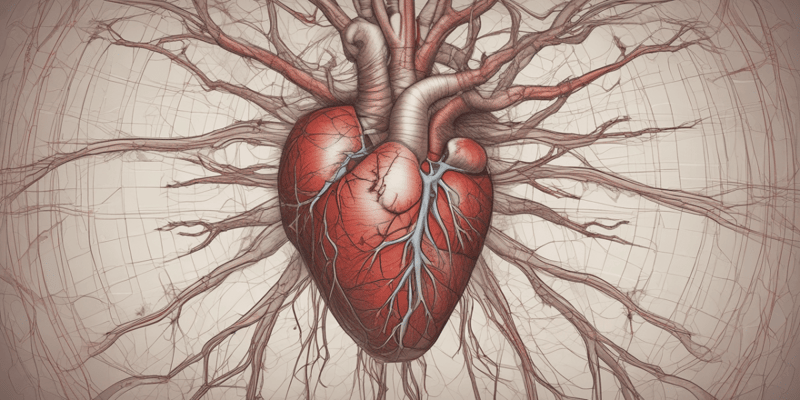Podcast
Questions and Answers
What is the primary role of one-way valves in veins?
What is the primary role of one-way valves in veins?
What distinguishes arterioles from arteries?
What distinguishes arterioles from arteries?
What is the main function of capillaries?
What is the main function of capillaries?
How do skeletal muscle contractions assist venous blood flow?
How do skeletal muscle contractions assist venous blood flow?
Signup and view all the answers
What characteristic of capillaries allows for efficient gas exchange?
What characteristic of capillaries allows for efficient gas exchange?
Signup and view all the answers
Which statement about venules is accurate?
Which statement about venules is accurate?
Signup and view all the answers
What is true about the flow of blood in the circulatory system?
What is true about the flow of blood in the circulatory system?
Signup and view all the answers
What is the primary function of arteries in the circulatory system?
What is the primary function of arteries in the circulatory system?
Signup and view all the answers
Which structural feature allows arteries to withstand high blood pressure?
Which structural feature allows arteries to withstand high blood pressure?
Signup and view all the answers
What mechanism helps veins prevent the backflow of blood?
What mechanism helps veins prevent the backflow of blood?
Signup and view all the answers
How does the blood pressure in veins compare to that in arteries?
How does the blood pressure in veins compare to that in arteries?
Signup and view all the answers
Which blood vessel type is primarily responsible for gas exchange in tissues?
Which blood vessel type is primarily responsible for gas exchange in tissues?
Signup and view all the answers
What role do arterioles play in the circulatory system?
What role do arterioles play in the circulatory system?
Signup and view all the answers
Which statement regarding veins is true?
Which statement regarding veins is true?
Signup and view all the answers
What is the main reason why veins have thinner walls compared to arteries?
What is the main reason why veins have thinner walls compared to arteries?
Signup and view all the answers
Study Notes
Blood Vessels
- The human circulatory system relies on a network of blood vessels to transport blood throughout the body.
- These vessels include arteries, arterioles, capillaries, venules, and veins, each with a specific structure and function.
Arteries
- Arteries carry blood away from the heart, delivering oxygenated blood to tissues and organs.
- They have thick, elastic walls containing smooth muscle and elastic fibers, allowing them to withstand the high pressure of blood pumped from the heart.
- Arteries expand and contract to maintain a steady blood flow despite pressure fluctuations.
Veins
- Veins carry blood back to the heart, carrying deoxygenated blood from tissues and organs.
- They have thinner, less muscular walls than arteries due to the lower pressure of blood returning to the heart.
- Veins contain one-way valves to prevent blood from flowing backward, particularly in the limbs.
- Muscle contractions assist the veins in pushing blood towards the heart.
Arterioles
- Arterioles are smaller, less elastic branches of arteries.
- Their walls are primarily composed of smooth muscle, enabling them to regulate blood flow to specific areas of the body by constricting or dilating.
Venules
- Venules are smaller branches of veins, connecting capillaries to larger veins.
- They are structurally similar to veins but smaller in size.
Capillaries
- Capillaries are the smallest blood vessels, connecting arterioles to venules.
- They are thin-walled and highly branched, forming extensive networks called capillary beds.
- Gas exchange (oxygen and carbon dioxide), nutrient delivery, and waste removal occur across the capillary walls.
- Blood cells pass through capillaries in a single file line, bending to fit through their narrow diameter.
- Capillary walls are composed of a single layer of endothelial cells, facilitating efficient exchange.
Studying That Suits You
Use AI to generate personalized quizzes and flashcards to suit your learning preferences.
Description
Explore the essential role of blood vessels in the human circulatory system. This quiz covers the structure and function of arteries and veins, highlighting how they transport oxygenated and deoxygenated blood throughout the body. Test your understanding of their properties and mechanisms!




